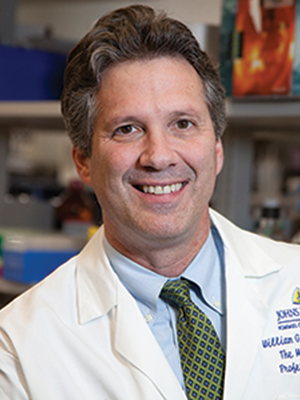
William G. Nelson, MD, PhD Photo by Joe Rubino
IN 2008, a Nobel Prize in Physiology or Medicine was awarded to
With several HPV vaccines now readily available, the prospects for eliminating cervical cancer hinge upon vaccine use, which varies substantially around the world. First, the bad news. Vaccination rates in the United States are notably low, with only 51% of adolescents receiving all recommended vaccine doses.
There are some 40 types of HPV that can be transmitted by sexual contact. Fortunately, most HPV infections are transient and asymptomatic, though some of the viruses cause cancers of the uterine cervix, vagina, anus, penis or oropharynx. Even with the advent of HPV vaccines, HPVs comprise the most common sexually transmitted infections in the world, with at least 12% of women and 21% of men currently infected. This reservoir of infection must be reduced to impact cervical cancer control.
When infection with a high-risk HPV, such as HPV 16 or HPV 18, persists in the cervix, precancerous lesions arise. Left untreated, they can progress to cervical cancer. For decades, the primary approach to cervical cancer prevention relied on detecting and treating precancer by using a microscope to look for abnormal cells scraped from the cervix. This procedure, called the Pap test (or Pap smear) was named for its inventor, Georgios Nikolaou Papanikolaou, a Greek physician who immigrated to the United States in 1913. Even as HPV vaccines have become available, Pap testing has remained an effective tool in reducing cervical cancer mortality. The U.S. Preventive Services Task Force (USPSTF) still endorses Pap test screening for cervical cancer every three years in women ages 21 to 65. Women ages 30 to 65 alternatively have the option of receiving HPV and Pap testing, or HPV testing alone, every five years.
The hope is that cervical cancer will begin to fade away as a major worldwide health threat as more people are inoculated with HPV vaccines before encountering the viruses. The U.S. Centers for Disease Control and Prevention (CDC) recommends that HPV vaccines be given in two doses to children 11-12 years old. (Vaccines can be started at age 9.) The CDC also advises that, to ensure efficacy, the vaccines be administered in three doses to adolescents and young adults if they have not already received the vaccines as children. Unfortunately, in 2018 only 54% of girls ages 13-17 were up to date with their vaccinations.
Now for the good news, and it is really good! HPV vaccines may be more effective than previously thought. Two recent reports—one from the HPV Vaccination Impact Study Group published in The Lancet, and the other from the CDC published in the Journal of Infectious Diseases—have detected greater reductions in HPV infections and precancerous lesions than would be expected given the number of adolescents fully vaccinated. This means either that the vaccine is more potent than expected—effective even when a full vaccine course is not completed—or that population-scale vaccination may have produced a “herd immunity” that protects even those not vaccinated by reducing the chance of HPV transmission. Support for herd immunity comes from a recent study in JAMA that found incidence of oral HPV infections that are preventable with vaccines declined 37% in unvaccinated men in the U.S. Oral HPV infection can lead to oral cancers.
The time has come for universal HPV vaccination. Cervical cancer and other HPV-associated cancers need to be banished to history. That would be great news!
Cancer Today magazine is free to cancer patients, survivors and caregivers who live in the U.S. Subscribe here to receive four issues per year.





